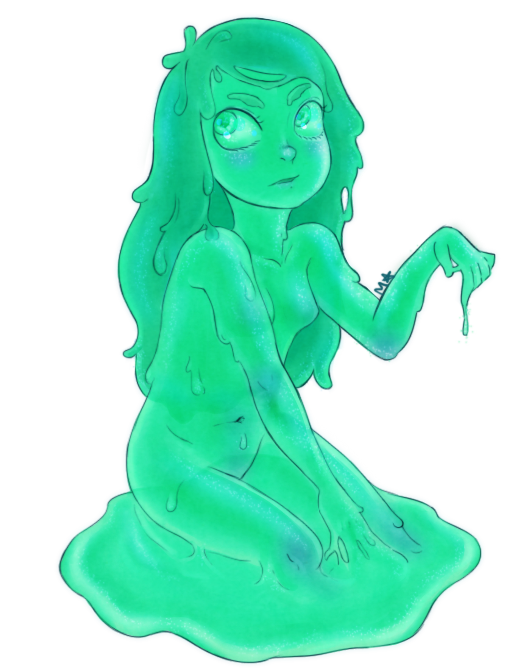Plasmid Lifeforms
Plasmid and plasmic lifeforms are frequently relegated to the back bench of the creature roster, left to linger with oozes, slimes, and puddings, and only appear as random monsters in sci-fi.
What is a Plasmid?
A Plasmid is a plasmic organism that can and does assume a humanoid form. Plasmic organisms are semi-gelatinous creatures that lack bones, internal organs, or other internal features common to complex animals and organisms. They share the common abilities to change their appearance and shape at will, and can move through extreme locations, such as slipping under a door, through a grate, and can form their bodies into useful shapes and forms. Plasmids also tend to be monochromatic, and some demonstrate translucency.
The Technoplasmid
Composed of nanites, the technoplasmid is a mimic without match. The technoplasmid can assume a variety of human shapes, complete with assuming colors and pigments, with the advantage of being metallic in nature. As such, the technoplasmid is very effective about turning their bodies into weapons, with emphasis frequently placed on bladed weapons. The technoplasmid is a very sophisticated complex machine that blurs the line between computer and robot. Technoplasmids are artificial in nature and are immune to any and all biological agents, and do not require any outside subsistence aside from electricity. They do tend to be vulnerable to electrical and ionic discharges and weaponry, extreme cold, and they cannot operate in space operations, as the conditions in space tend to burn out the nanites that compose them and quickly cold weld to themselves, forming a charred metal husk.
The T-1000 from Terminator 2: Judgement Day is the primary example of a technoplasmid organism.

The Mega-Cell Plasmid
The Mega-Cell Plasmid is basically a sentient amoeba in excess of a meter tall and over 75 kilograms in weight. The mega cell plasmid has a malleable cellular wall and uses it to form a fluid filled body. Mega cell plasmids are osmotic feeders and function as living filters of their environment. They can have a variety of intelligences, ranging from primitive and animal-like, to being capable of advanced and complex thought. They are also mimics, and will adopt the physical form of the dominant lifeform in an area. Once these alien lifeforms encounter space faring humans, they will adopt the form of humans to integrate into their society, adopting it as their own and hiding in it's bulk.

The Slime Plasmid
Similar to the mega-cell, the Slime Plasmid is a complex organism that has adopted shapeshifting as it's mode of hunting and protection, emulating powerful creatures to avoid predation, and to use their more sophisticated hunting methods. In the wild, slime plasmids are simple plasmics and will simply lurk as amorphous blobs suspended in water, dark places, and so forth waiting for something to come too close. Where the mega-cell is a filter feeder, the slime plasmid is a hunter, and envelops it's prey whole and dissolves them. Slimes adopt some of the abilities and forms of the creatures they devour. Once one consumes something intelligent, it becomes intelligent, and it's offspring retains this ability.
The Blob, before it becomes a massive creature, demonstrates many of the features of the slime plasmid, hunting behavior, mimicking it's prey, and demonstrating intelligence.

Rampant Slime: Slime plasmids exist in a state of concentration, retaining any regular form requires their constant attention, and as their disincorporated minds slip and wander, their physical form follows. Slimes are well known for being 'bad poker players' and have a large number of tells. As such, most slimes don't bother with mental or emotional deception as they are very bad at it. A slime can be affected by madness as much as any other intelligent creature, and as such can assume rather horrific forms and bestial behavior.
Author's Note: The slime humanoid is a bit of a staple in the anime and deviant art community, albeit with large bubbly boobs and overstated slime dripping sexual attributes. I thought about this for a while, and it occurred to me that the traits being demonstrated displayed intelligence on the part of the creatures, and if the hentai weirdness, vore, and other deviancy was stripped from it, you have a sentient and very alien lifeform to run. They are intelligent, and have mimicking abilities, and in contrast to more 'complex' lifeforms lack many of our inherit features, such as breakable bones, fixed gender, and other requirements. They can mix genetic information and breed (not the machines, obviously) or they can undergo fission and reproduce asexually.
Using Plasmids as NPCs and PCs
Plasmids have a different take on basic abilities. With fluid forms, they have a fixed number of points that they can freely move between physical attributes. Appearance is likewise mutable, but hiding their plasmid nature is something that only the oldest and most sophisticated plasmids can pull off. Mental abilities and other character traits remain the same as a basic NPC would be capable of.
Weaknesses: Plasmids typically need moist environments are are vulnerable to drying out. They dislike extreme cold, and are ambivalent to heat, so long as it is humid. Having a semi-permeable outer layer, most plasmids and plasmics are vulnerable to environmental hazards like chemicals, toxins, poisons, and other negative elements. Plasmids are also relatively direct in thought and demeanor, and avoid things that require long periods of sustained attention.
Advantages: Plasmids can change shape, and are able to quickly adapt to environmental hazards with ease compared to humans and other fixed creatures. Plasmids are typically amphibious, can go long periods without feeding, and are not warm blooded, allowing them to bypass many heat sensors, machines designed to detect humans, and are relatively hard to keep captive.
Not Registered Yet? No problem.
Do you want Strolenati super powers? Registering. That's how you get super powers! These are just a couple powers you receive with more to come as you participate.
- Upvote and give XP to encourage useful comments.
- Work on submissions in private or flag them for assistance.
- Earn XP and gain levels that give you more site abilities (super powers).
- You should register. All your friends are doing it!
? Responses (4)
Dralasites (from Star Frontiers) might fall under this category as well, though they are far less plastic then those listed here and have more defined skin.
Also whatever Odo was on Deep Space 9
I should have voted on this before.
Solid introduction to the concept.